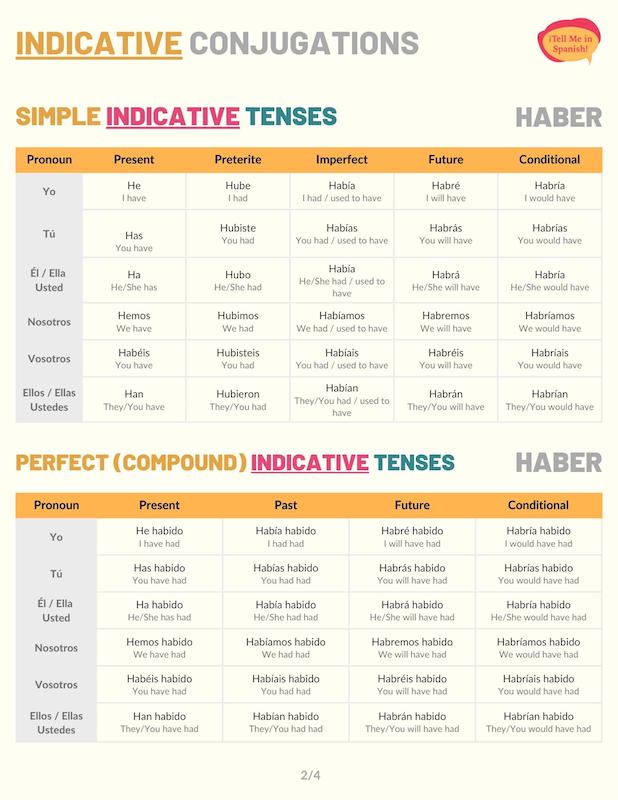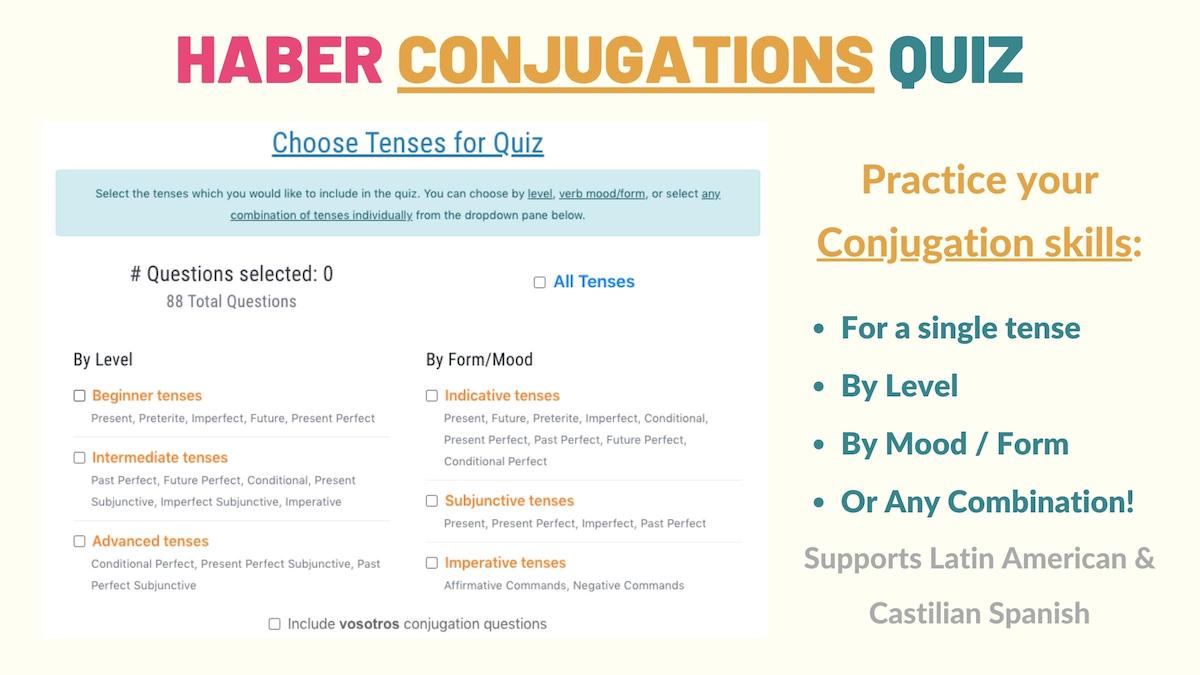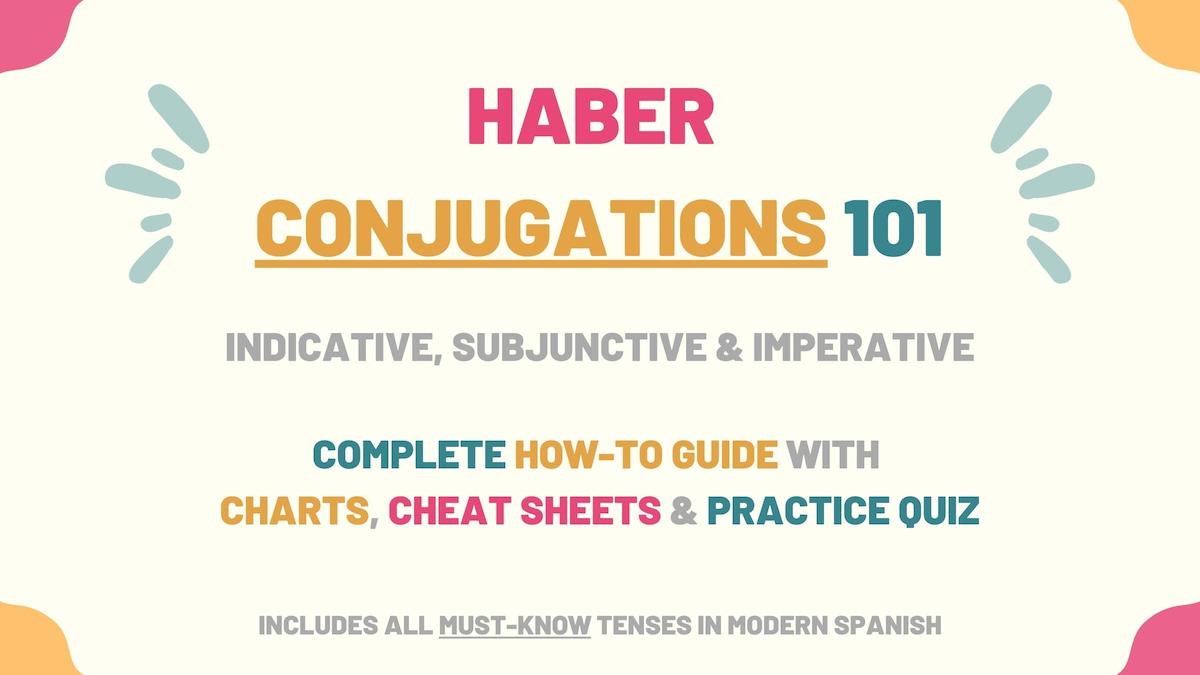Haber is an auxiliary verb in Spanish. Since you’ll use it to build tenses and key meanings, you must get familiar with the haber conjugation charts. So, here is a summary of what we’ll cover in this guide:
- Haber Overview
- Indicative Tenses of Haber Conjugations
- Subjunctive Tenses of Haber Conjugations
- Imperative (Commands) of Haber Conjugations
- Uses & Examples
- Download Haber Conjugation Tables & Uses Cheat sheets
- Haber Conjugation Practice Quiz
Overview of Haber
| Verb Characteristic | Property |
|---|---|
| Verb Type | -ER |
| Irregular | Yes |
| Infinitive | Haber |
| Gerund (Present Participle) Form | Habiendo |
| Past Participle Form | Habido |
| Synonyms | Existir, tener. |
Irregularities:
- Present: h for all subject pronouns.
- Preterite: hub for all subject pronouns.
- Future & Conditional: habr for all subject pronouns.
- Present Subjunctive: hay for all subject pronouns.
- Imperfect Subjunctive: hubie for all subject pronouns.
In Spanish, haber needs a complement in order to provide any meaning. Use nouns when working as an impersonal form, such as hay (there is/there are). As an auxiliary verb, haber must be combined with other verbs. You can learn more about how to use haber in the section Uses & Meanings.
Indicative Conjugations of Haber
Present tense
Haber conjugations in the present tense are formed with the stem h and both -AR and -ER present endings. Hay is the impersonal form of haber in the present tense. We conjugate this verb to this tense to formally express obligation or to form the indicative present perfect tense.
For example: Hemos de ayudar a nuestros amigos.
| Person | Conjugation | Translation |
|---|---|---|
| Yo | He | I have |
| Tú | Has | You have |
| Él / Ella Usted | Ha | He/She has You (formal) have |
| Nosotros | Hemos | We have |
| Vosotros | Habéis | You have |
| Ellos / Ellas Ustedes | Han | They have You (plural) have |
Take Note: Although it’s translated as ‘to have’, in Spanish, haber is not used to talk about possession. In this context, you must use the verb tener instead. Since they’re both essential verbs, you must understand the differences between haber and tener in Spanish.
Preterite tense
Haber preterite conjugation is also irregular. These past preterite forms are conjugated with the stem hub. When conjugated to the preterite tense, haber can be used to describe the presence of something at some point in the past.
For example: No hubo leche.
| Person | Conjugation | Translation |
|---|---|---|
| Yo | Hube | I had |
| Tú | Hubiste | You had |
| Él / Ella Usted | Hubo | He/She had You (formal) had |
| Nosotros | Hubimos | We had |
| Vosotros | Hubisteis | You had |
| Ellos / Ellas Ustedes | Hubieron | They had You (plural) had |
Imperfect tense
Haber imperfect conjugations are regular. We use haber conjugated to the past imperfect tense to form the Spanish past perfect tense. You can also use the impersonal form había to explain what there was (the presence or existence of something) at some point in the past.
For example: Había mucha gente en el parque.
| Person | Conjugation | Translation |
|---|---|---|
| Yo | Había | I had I used to have |
| Tú | Habías | You had You used to have |
| Él / Ella Usted | Había | He/She had He/She used to have You (formal) had You (formal) used to have |
| Nosotros | Habíamos | We had We used to |
| Vosotros | Habíais | You had You used to |
| Ellos / Ellas Ustedes | Habían | They had They used to You (plural) had You (plural) used to |
Take Note: Había una vez (once upon a time) is a Spanish expression used to start stories. This expression is formed with haber’s imperfect form.
Near future
The Spanish immediate future of haber is formed with ir (present tense) + a + haber. We use these haber conjugations to talk about the things there will be somewhere. For instance: Escuché que va a haber música en vivo.
| Person | Conjugation | Translation |
|---|---|---|
| Yo | Voy a haber | I’m going to have |
| Tú | Vas a haber | You’re going to have |
| Él / Ella Usted | Va a haber | He/She is going to have You (formal) are going to have |
| Nosotros | Vamos a haber | We’re going to have |
| Vosotros | Vais a haber | You’re going to have |
| Ellos / Ellas Ustedes | Van a haber | They’re going to have You (plural) are going to have |
Future simple tense
Haber future tense conjugation is formed with the irregular stem habr. These future forms are used to form the future perfect tense in Spanish. You can also use the impersonal form habrá to discuss the things there will be somewhere. En unos minutos, habremos aprendido a conjugar haber.
| Person | Conjugation | Translation |
|---|---|---|
| Yo | Habré | I will have |
| Tú | Habrás | You will have |
| Él / Ella Usted | Habrá | He/She will have You (formal) will have |
| Nosotros | Habremos | We will have |
| Vosotros | Habréis | You (formal) will have |
| Ellos / Ellas Ustedes | Habrán | They will have You (plural) will have |
Conditional tense
Use the stem habr to conjugate haber to the conditional indicative tense in Spanish. In the conditional tense, this verb is used to form the conditional perfect tense or, in its impersonal form, to refer to the things there would be somewhere.
For example: ¿Por qué habría tanta gente?
| Person | Conjugation | Translation |
|---|---|---|
| Yo | Habría | I would have |
| Tú | Habrías | You would have |
| Él / Ella Usted | Habría | He/She would have You (formal) would have |
| Nosotros | Habríamos | We would have |
| Vosotros | Habríais | You would have |
| Ellos / Ellas Ustedes | Habrían | They would have You (plural) would have |
Present perfect tense
The present perfect indicative tense is the combination of haber in the present tense + past participle. When conjugated to this tense, haber is commonly used in its impersonal form (third-person singular) to refer to the things there have or haven’t been somewhere.
For example: Ha habido muchas irregularidades.
| Person | Conjugation | Translation |
|---|---|---|
| Yo | He habido | I have had |
| Tú | Has habido | You have had |
| Él / Ella Usted | Ha habido | He/She has had You (formal) have had |
| Nosotros | Hemos habido | We have had |
| Vosotros | Habéis habido | You have had |
| Ellos / Ellas Ustedes | Han habido | They have had You (plural) have had |
Past perfect
When conjugated to the past perfect tense in Spanish, haber is used in its impersonal form to refer to the things that had been in a certain place before another past event. For example: Desde enero, no había habido tanta gente.
| Person | Conjugation | Translation |
|---|---|---|
| Yo | Había habido | I had had |
| Tú | Habías habido | You had had |
| Él / Ella Usted | Había habido | He/She had had You (formal) had had |
| Nosotros | Habíamos habido | We had had |
| Vosotros | Habíais habido | You had had |
| Ellos / Ellas Ustedes | Habían habido | They had had You (plural) had had |
Future perfect
The future perfect forms of haberare formed with haber future form + past participle form of ‘haber’. In this tense, this verb communicates that something will have been in a certain place before or by a certain point in the future. ¿Habrá habido algún problema?
| Person | Conjugation | Translation |
|---|---|---|
| Yo | Habré habido | I will have had |
| Tú | Habrás habido | You will have had |
| Él / Ella Usted | Habrá habido | He/She will have had You (formal) will have had |
| Nosotros | Habremos habido | We will have had |
| Vosotros | Habréis habido | You will have had |
| Ellos / Ellas Ustedes | Habrán habido | They will have had You (plural) will have had |
Conditional perfect
We conjugate haber to the conditional perfect tense in Spanish to communicate that there would have been something if a past circumstance had been met. For instance: Si no hubiéramos hecho nada, habría habido más problemas.
| Person | Conjugation | Translation |
|---|---|---|
| Yo | Habría habido | I would have had |
| Tú | Habrías habido | You would have had |
| Él / Ella Usted | Habría habido | He/She would have had You (formal) would have had |
| Nosotros | Habríamos habido | We would have had |
| Vosotros | Habríais habido | You would have had |
| Ellos / Ellas Ustedes | Habrían habido | They would have had You (plural) would have had |
Progressive tenses
The progressive tenses in Spanish are formed by conjugating the verb estar + habido (present participle). These conjugations of haber are used to emphasize that there is something at the moment of speaking. For example: Está habiendo muchas quejas.
| Progressive Tense | Formula | Translation Example |
|---|---|---|
| Present | Estar (present) + habiendo | I am having |
| Preterite | Estar (preterite) + habiendo | You were having |
| Imperfect | Estar (imperfect) + habiendo | He was having |
| Future | Estar (future) + habiendo | We will be having |
| Conditional | Estar (conditional) + habiendo | They would be having |
Haber Subjunctive Conjugations
You must use the subjunctive mood in Spanish to talk about wishes, suggestions, hopes, expectations, requests, doubts, or hypothetical situations. Haber subjunctive conjugations are used to build perfect subjunctive tenses or to refer to the potential presence of something (impersonal forms).
In the sections below, you’ll find haber conjugation charts for the most important subjunctive tenses.
Present subjunctive
The haber subjunctive conjugations are formed with the stem hay. When working as an auxiliary verb, these conjugations of haber are used to form the present perfect subjunctive. You can also use the third-person singular conjugation to hope there is something in a certain place.
For example: No creo que ustedes hayan ido a la tienda or Espero que todavía haya pizza.
| Person | Conjugation | Translation |
|---|---|---|
| Yo | Haya | I have |
| Tú | Hayas | You have |
| Él / Ella Usted | Haya | He/She has You (formal) have |
| Nosotros | Hayamos | We have |
| Vosotros | Hayáis | You have |
| Ellos / Ellas Ustedes | Hayan | They have You (plural) have |
Present perfect subjunctive
In Spanish, the present perfect subjunctive of ‘haber’ is formed by conjugating haber to the imperfect tense + past participle (habido). Use the conjugations to wonder or express doubt on whether there is or isn’t something. For instance: Dudo que haya habido camisas rojas.
| Person | Conjugation | Translation |
|---|---|---|
| Yo | Haya habido | I have had |
| Tú | Hayas habido | You have had |
| Él / Ella Usted | Haya habido | He/She has had You (formal) have had |
| Nosotros | Hayamos habido | We have had |
| Vosotros | Hayáis habido | You have had |
| Ellos / Ellas Ustedes | Hayan habido | They have had You (plural) have had |
Imperfect subjunctive
Hubie is the stem we must use to conjugate haber to the Spanish imperfect subjunctive tense. If working as an auxiliary verb, these conjugations are used to form the past perfect subjunctive. You can also use haber’s impersonal form to express past wishes related to the existence of something in a place.
For example: Me gustaría que hubiera más flores or Si hubiera sabido, no habría ido.
Depending on the type of Spanish (Latin American or Castilian) you use, the imperfect subjunctive tense has two conjugation models:
Latin American Spanish version
| Person | Conjugation | Translation |
|---|---|---|
| Yo | Hubiera | I had |
| Tú | Hubieras | You had |
| Él / Ella Usted | Hubiera | He/She had You (formal) had |
| Nosotros | Hubiéramos | We had |
| Ellos / Ellas Ustedes | Hubieran | They had You (plural) had |
Note: Because vosotros is not used in Latin American Spanish. So, the haber conjugation for this subject pronoun has not been included in the conjugation chart above.
Castilian Spanish version
| Person | Conjugation | Translation |
|---|---|---|
| Yo | Hubiese | I had |
| Tú | Hubieses | You had |
| Él / Ella Usted | Hubiese | He/She had You (formal) had |
| Nosotros | Hubiésemos | We had |
| Vosotros | Hubieseis | You had |
| Ellos / Ellas Ustedes | Hubiesen | They had You (plural) had |
Past perfect subjunctive
When conjugated to the past perfect subjunctive, haber conveys that there would have been something if a past condition was met. These subjunctive conjugations can also express regret because there was or wasn’t something in a place.
For example: Hubiera sido más agradable si no hubiera habido tanta gente.
| Person | Conjugation | Translation |
|---|---|---|
| Yo | Hubiera habido | I had had |
| Tú | Hubieras habido | You had had |
| Él / Ella Usted | Hubiera habido | He/She had had You (formal) had had |
| Nosotros | Hubiéramos habido | We had had |
| Vosotros | Hubierais habido | You had had |
| Ellos / Ellas Ustedes | Hubieran habido | They had had You (plural) had had |
Haber Imperative Conjugations
In Spanish, we use the imperative mood to command people on what to do or not to do. Because the perfect tenses refer to actions that were already completed or will take place someday, in its auxiliary form, haber cannot be conjugated to the imperative tense.
Additionally, none of the haber impersonal forms (hay, hube, había, etc) can be conjugated to the imperative tenses. This is because you cannot command something to exist.
Meanings of Haber & Examples
Now that you’ve had a chance to learn how to conjugate haber in Spanish, check the following examples of how to use this verb.
- As an auxiliary verb in the perfect tenses
[Haber conjugated] + [past participle]
Ya he ido a ese lugar varias veces
I have already gone to that place many times.
Cuando llegamos, el camión ya se había ido.
When we arrived, the bus had already left.
- To express existence
[Third person singular of haber] + [determiner] + [noun]
¿Por qué hay tanta gente en la calle?
Why are there so many people on the street?
En unos días, habrá más información.
There will be more information in a few days.
Take Note: Hay is one of the first impersonal forms of haber you’ll learn. However, as you can see in the examples above, you can use these impersonal forms in different tenses in Spanish. In this article, you can check how to use hay in Spanish and other haber forms.
Download Haber Conjugation Tables & Uses Cheat sheets

Haber is one of the most crucial verbs to learn in Spanish since its an auxiliary verb used to build all of the perfect tenses. It’s also an irregular verb in many tenses, which can make it difficult to learn. So, I’ve created a PDF you can download which contains all the haber conjugation charts in the key tenses you need to learn Spanish in today’s day and age. It also contains the uses and real-world example sentences so you can see how to apply it in your conversations.
Practice Quiz: Haber Conjugation

Now that you’ve learned how to conjugate haber is all its various tenses, you can drill yourself by taking the haber conjugation practice quiz. Once you’ve memorized all of its different forms, you’ll be able to speak Spanish at a much more proficient level.

